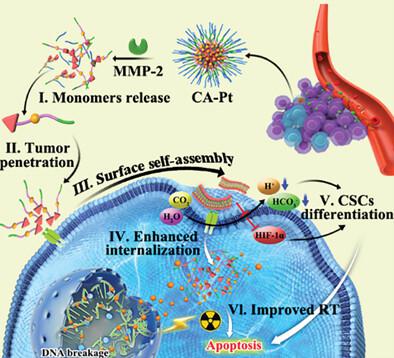当前位置:
X-MOL 学术
›
Adv. Mater.
›
论文详情
Our official English website, www.x-mol.net, welcomes your
feedback! (Note: you will need to create a separate account there.)
Cancer Stem-Like Cells-Oriented Surface Self-Assembly to Conquer Radioresistance
Advanced Materials ( IF 27.4 ) Pub Date : 2023-06-08 , DOI: 10.1002/adma.202302916 Qian Wang 1 , Hongmei Cao 1 , Xiaoxue Hou 1 , Dianyu Wang 1 , Zhilong Wang 1 , Yue Shang 1 , Shuqin Zhang 1 , Jinjian Liu 1 , Chunhua Ren 1 , Jianfeng Liu 1
Advanced Materials ( IF 27.4 ) Pub Date : 2023-06-08 , DOI: 10.1002/adma.202302916 Qian Wang 1 , Hongmei Cao 1 , Xiaoxue Hou 1 , Dianyu Wang 1 , Zhilong Wang 1 , Yue Shang 1 , Shuqin Zhang 1 , Jinjian Liu 1 , Chunhua Ren 1 , Jianfeng Liu 1
Affiliation

|
Cancer stem-like cells (CSCs), capable of indefinite self-renewal and differentiation, are considered to be the root cause of tumor radiotherapy (RT) resistance. However, the CSCs-targeted therapy still remains to be a great challenge because they are commonly located in the deep tumor making drugs hard to approach, and their hypoxic and acidic niche can further aggravate radioresistance. Herein, based on the finding that hypoxic CSCs highly express carbonic anhydrase IX (CAIX) on the cell membrane, a CAIX-targeted induced in situ self-assembly system on the surface of CSC is reported to overcome hypoxic CSC-mediated radioresistance. Via the sequential processes of “monomer release-target accumulation-surface self-assembly”, the constructed peptide-based drug delivery system (CA-Pt) exhibits the advantages of deep penetration, amplified CAIX inhibition, and enhanced cellular uptake, which greatly relieves the hypoxic and acidic microenvironment to promote the hypoxic CSC differentiation and combines with platinum to boost the RT-inducing DNA damage. In both lung cancer tumor mouse and zebrafish embryo models, CA-Pt treatment can effectively assist RT in suppressing tumor growth and preventing tumor invasion and metastasis. This study uses a surface-induced self-assembly strategy to differentiate hypoxic CSCs, which may provide a universal treatment strategy for overcoming tumor radioresistance.
中文翻译:

癌症干细胞样表面自组装克服放射抗性
癌症干细胞样细胞(CSC)具有无限的自我更新和分化能力,被认为是肿瘤放疗(RT)耐药的根本原因。然而,CSCs靶向治疗仍然是一个巨大的挑战,因为它们通常位于肿瘤深部,使得药物难以接近,而且它们的缺氧和酸性生态位会进一步加剧放射抗性。在此,基于缺氧CSC在细胞膜上高度表达碳酸酐酶IX(CAIX)的发现,报道了在CSC表面上靶向CAIX诱导的原位自组装系统,以克服缺氧CSC介导的放射抗性。通过“单体释放-目标积累-表面自组装”的顺序过程,构建的基于肽的药物递送系统(CA-Pt)表现出深度渗透、放大CAIX抑制和增强细胞摄取的优点,极大地减轻了药物的负担。低氧和酸性微环境促进低氧CSC分化,并与铂结合以增强RT诱导的DNA损伤。在肺癌肿瘤小鼠和斑马鱼胚胎模型中,CA-Pt治疗可以有效辅助RT抑制肿瘤生长,防止肿瘤侵袭和转移。本研究采用表面诱导自组装策略来分化缺氧CSC,这可能为克服肿瘤放射抗性提供通用的治疗策略。
更新日期:2023-06-08
中文翻译:

癌症干细胞样表面自组装克服放射抗性
癌症干细胞样细胞(CSC)具有无限的自我更新和分化能力,被认为是肿瘤放疗(RT)耐药的根本原因。然而,CSCs靶向治疗仍然是一个巨大的挑战,因为它们通常位于肿瘤深部,使得药物难以接近,而且它们的缺氧和酸性生态位会进一步加剧放射抗性。在此,基于缺氧CSC在细胞膜上高度表达碳酸酐酶IX(CAIX)的发现,报道了在CSC表面上靶向CAIX诱导的原位自组装系统,以克服缺氧CSC介导的放射抗性。通过“单体释放-目标积累-表面自组装”的顺序过程,构建的基于肽的药物递送系统(CA-Pt)表现出深度渗透、放大CAIX抑制和增强细胞摄取的优点,极大地减轻了药物的负担。低氧和酸性微环境促进低氧CSC分化,并与铂结合以增强RT诱导的DNA损伤。在肺癌肿瘤小鼠和斑马鱼胚胎模型中,CA-Pt治疗可以有效辅助RT抑制肿瘤生长,防止肿瘤侵袭和转移。本研究采用表面诱导自组装策略来分化缺氧CSC,这可能为克服肿瘤放射抗性提供通用的治疗策略。































 京公网安备 11010802027423号
京公网安备 11010802027423号